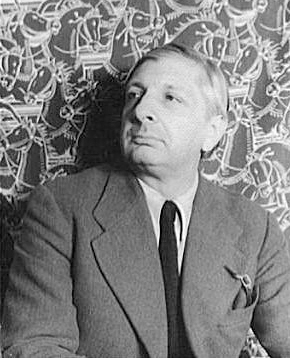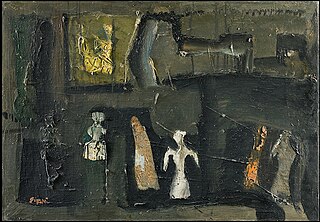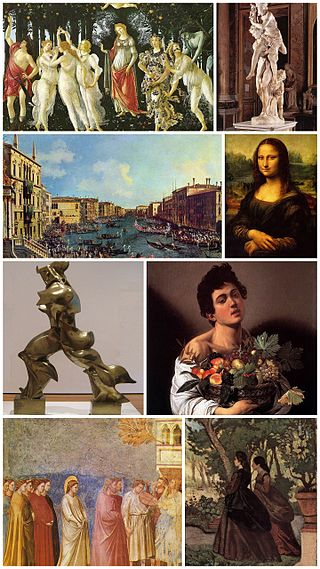Related Research Articles

A mannequin is a doll, often articulated, used by artists, tailors, dressmakers, window dressers and others, especially to display or fit clothing and show off different fabrics and textiles. Previously, the English term referred to human models and muses ; the meaning as a dummy dating from the start of World War II.

Giuseppe Maria Alberto Giorgio de Chirico was an Italian artist and writer born in Greece. In the years before World War I, he founded the scuola metafisica art movement, which profoundly influenced the surrealists. His best-known works often feature Roman arcades, long shadows, mannequins, trains, and illogical perspective. His imagery reflects his affinity for the philosophy of Arthur Schopenhauer and of Friedrich Nietzsche, and for the mythology of his birthplace.

Arnold Böcklin was a Swiss Symbolist painter. His five versions of the Isle of the Dead inspired works by several late-Romantic composers.

Carlo Carrà was an Italian painter and a leading figure of the Futurist movement that flourished in Italy during the beginning of the 20th century. In addition to his many paintings, he wrote a number of books concerning art. He taught for many years in the city of Milan.

Metaphysical painting or metaphysical art was a style of painting developed by the Italian artists Giorgio de Chirico and Carlo Carrà. The movement began in 1910 with de Chirico, whose dreamlike works with sharp contrasts of light and shadow often had a vaguely threatening, mysterious quality, "painting that which cannot be seen". De Chirico, his younger brother Alberto Savinio, and Carrà formally established the school and its principles in 1917.

Mario Sironi was an Italian Modernist artist who was active as a painter, sculptor, illustrator, and designer. His typically somber paintings are characterized by massive, immobile forms.

The Disquieting Muses is a painting by the Italian metaphysical painter Giorgio de Chirico. There are two versions of this painting, the original is in the Gianni Mattioli private collection, in Milan, and the other is at the Pinakothek der Moderne, in Munich.

Giorgio Morandi was an Italian painter and printmaker widely known for his subtly muted still-life paintings of ceramic vessels, flowers, and landscapes—their quiet, meditative quality reflecting the artist's rejection of the tumult of modern life.

Novecento Italiano was an Italian artistic movement founded in Milan in 1922 to create an art based on the rhetoric of the fascism of Mussolini.

Italian Contemporary art refers to painting and sculpture in Italy from the early 20th century onwards.
Gian Paolo Dulbecco is an Italian painter.

Achille Funi was an Italian painter who painted in a Modernist take on the Neoclassical style.

The Museo del Novecento is a museum of twentieth-century art in Milan, in Lombardy in northern Italy. It is housed in the Palazzo dell'Arengario, near Piazza del Duomo in the centre of the city.

The Galleria Comunale d'Arte Moderna is the museum of modern and contemporary art of the city of Rome, Italy. It is housed in a former Barefoot Carmelite monastery dating from the 17th century and adjacent to the church of San Giuseppe a Capo le Case, at 24 Via Francesco Crispi.

Mario Tozzi was an Italian painter. He was awarded the Legion of Honour by the French government.

René or Renato Herbert Paresce was a Swiss-born Italian painter and writer.

Raissa Samojlovna Calza was a Ukrainian dancer who became a prominent classical archaeologist of Roman portraiture. When she was young, she fled to Italy and France following the Russian Revolution.

Hebdomeros is a 1929 book by Italian painter Giorgio de Chirico. Chirico did not produce any other long-form writing. The book is narrated in the third person and loosely concerns the movement of a man, Hebdomeros, westward. Writing in The Kenyon Review, Alan Burns referred to the text as a "surrealist dream novel".

Renzo Eusebi, Italian painter, sculptor of contemporary art. He is co-founder of the artistic movements of Transvisionismo (1995) and GAD.

Claudio Detto is an Italian painter of contemporary art.
References
- ↑ Holzhey, Magdalena (2005). Giorgio de Chirico, 1888–1978: The modern myth. Köln: Taschen. p. 57. ISBN 3822841528.
- ↑ Holzhey, Magdalena (2005). Giorgio de Chirico, 1888–1978: The modern myth. Köln: Taschen. p. 61. ISBN 3822841528.
- ↑ Holzhey, Magdalena (2005). Giorgio de Chirico, 1888–1978: The modern myth. Köln: Taschen. p. 60. ISBN 3822841528.
- ↑ Museo del Novecento, Milan, Electa, 2010 (Italian)